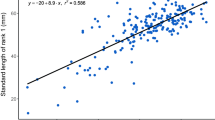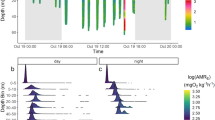Sex change is not the only way these fish achieve dominance — they grow into the role.
Abstract
Conflicts of interest are part and parcel of living in a social group, although these can reduce the fitness of individual members. Here I show that clownfish (Amphiprion percula) adjust their size and growth rate according to their position in the group hierarchy, maintaining a well-defined size difference with respect to individuals above them in social rank. This strategy to prevent conflict is a surprising departure from the more usual ploy used by many animals of modifying their behaviour within the group1,2.
This is a preview of subscription content, access via your institution
Access options
Subscribe to this journal
Receive 51 print issues and online access
$199.00 per year
only $3.90 per issue
Buy this article
- Purchase on Springer Link
- Instant access to full article PDF
Prices may be subject to local taxes which are calculated during checkout

S. PATERSON

Similar content being viewed by others
References
Reeve, H. K. Nature 358, 147–149 (1992).
Balshine-Earn, S., Neat, F. C., Reid, H. & Taborsky, M. Behav. Ecol. 9, 432–438 (1998).
Allen, G. R. The Anemonefishes: Their Classification and Biology (T. F. H. Publications, Neptune City, New Jersey, 1972).
Elliott, J. K. & Mariscal, R. N. Mar. Biol. 138, 23–36 (2001).
Fricke, H. W. Z. Tierpsychol. 50, 313–326 (1979).
Fautin, D. G. Symbiosis 14, 143–160 (1992).
Kokko, H. & Johnstone, R. A. Proc. R. Soc. Lond. B 266, 571–578 (1999).
Buston, P. M. Proc. R. Soc. Lond. B (submitted).
Field, J., Shreeves, G. & Sumner, S. Behav. Ecol. Sociobiol. 45, 378–385 (1999).
Buston, P. M. Behav. Ecol. (in the press).
Author information
Authors and Affiliations
Corresponding author
Ethics declarations
Competing interests
The author declares no competing financial interests.
Rights and permissions
About this article
Cite this article
Buston, P. Size and growth modification in clownfish. Nature 424, 145–146 (2003). https://doi.org/10.1038/424145a
Issue Date:
DOI: https://doi.org/10.1038/424145a
This article is cited by
-
Positive spatial autocorrelation in three habitat quality indicators sets the stage for evolution of adaptive dispersal plasticity in a coral reef fish
Coral Reefs (2023)
-
Clownfish triggers plasticity in the acoustic communication of the three-spot damselfish
Marine Biology (2023)
-
Vertebrate growth plasticity in response to variation in a mutualistic interaction
Scientific Reports (2022)
-
Monogamy and protandry caused by exclusion of the same sex and random pairing in anemonefishes: a simulation model and aquarium experiments
Journal of Ethology (2022)
-
Rank change and growth within social hierarchies of the orange clownfish, Amphiprion percula
Marine Biology (2022)
Comments
By submitting a comment you agree to abide by our Terms and Community Guidelines. If you find something abusive or that does not comply with our terms or guidelines please flag it as inappropriate.



